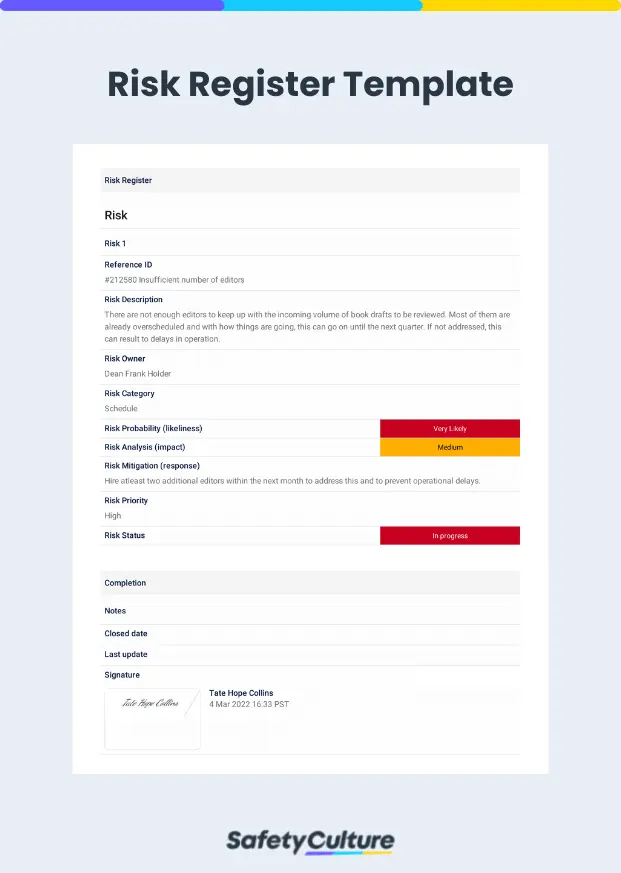What is a Risk Register?
A risk register, also sometimes called a risk log, is a document project managers use to list down risks early in the project planning process to identify risks and how to mitigate them. This list is an important document in risk management for projects and businesses in all industries.
Role in Risk Management
When creating and managing a project, a major part of it should be attributed to risk management. Generally, risk management is the umbrella term for all things risk-related during a project’s planning and execution stages. A “risk” is defined here as not only something that may cause harm, but also anything that may influence how the project’s final outcome will turn out to be. Following this, a risk management plan is then made, covering the analysis and assessment of risks. This covers not only the risks that may happen before the project is executed but also the risks that happen during the execution itself. Other parts of risk management are risk analysis and risk assessment.
An important factor to any successful risk management program is to have a risk register before project execution. As a risk register is the compilation of identified risks in the planning stages of a project, it is often referred to during the project planning and execution as a reference for risks. It is also used as a supplementary document in helping the project manager keep track of the processes undertaken by the team and to prevent delays, as they would continuously refer to it to know what to avoid and what to do better.
Improve your GRC management
Simplify risk management and compliance with our centralized platform, designed to integrate and automate processes for optimal governance.
Explore nowElements of a Risk Register
There is no one way to create and use a risk register. Different businesses would have different needs and risks, so each risk register can be created differently. However, the typical risk register has the following elements:
- Risk identification and description: what is the risk and a brief description of it
- Risk category: the kind of risk
- Risk probability or likeness: how likely the risk would happen or worsen
- Risk analysis: impact of the risk, can be described or ranked through a scale
- Risk mitigation: the actions to take in response to the risk
- Risk priority: level of priority or urgency to address
- Risk status: progression or status of the risk or the plans taken to address it
Below is a risk register example that specifically utilizes a risk register template:
- Reference ID: #212580 Insufficient number of editors
- Risk Description: There are not enough editors to keep up with the incoming volume of book drafts to be reviewed. Most of them are already overscheduled and with how things are going, this can go on until the next quarter. If not addressed, this can result to delays in operation.
- Risk Owner: Dean Frank Holder
- Risk Category: Schedule
- Risk Probability: Very likely
- Risk Analysis: Medium
- Risk Mitigation: Hire atleast two additional editors within the next month to address this and to prevent operational delays.
- Risk Priority: High
- Risk Status: In progress
These logs are straight to the point and easy to use, maximizing them allows businesses to keep track of risks and mitigate them.
Create your own Risk Register Template
Build from scratch or choose from our collection of free, ready-to-download, and customizable templates.
Browse Risk Register Templates10 Risk Register Use Examples
Risk registers are used in almost all departments or lines of business in a company. Here are some examples of how they are used and applied per industry:
1. Construction
As belonging to one of the biggest and most dangerous industries, construction companies are known for dutifully maintaining risk registers. A risk register is a necessity for the preconstruction phase of any construction project as it helps in creating a plan on how to do the construction proper. Assessing risks and planning for them early on helps not only streamline the construction process, but it also helps prevent any harmful incidents from occurring. A risk register can also help in creating back-up plans for when natural disasters happen, or when other events outside of the managers’ control occur.
When constructing buildings, an environmental risk register can also be used. This kind of risk register is specifically used to help determine the environmental impact a certain project will have.
2. Corporate Businesses
Although corporate businesses have less chances of workplace injuries or violence, there are still many risks to consider that can hamper operations. The improvements that can stem from having a risk register can then improve productivity and profitability.
Having a risk register helps businesses in the corporate field improve existing processes. With a risk register to help identify risks, managers can discover errors and work to improve on them by developing new policies to address issues. Some businesses may also use an environmental risk register depending on the nature of work.
3. Customer Service
Jobs in the field of customer service are considered by the Occupational Safety and Health Administration (OSHA) to be more prone to workplace violence compared to other jobs. Because of this, some employers have taken to using risk registers to help prevent any untoward incidents towards themselves and their employees. Additionally, a risk register can also be used as a reference on what to do in case of emergencies as well.
4. IT and Cybersecurity
Risk registers are also very common in the fields of Information Technology (IT) and cybersecurity, as both fields deal with many risks daily. Risk registers allow professionals in these fields to not only identify and measure risks in one place, but they also help in creating new ways to improve cybersecurity.
Security risk registers or information security risk registers, in particular, are the most commonly used kind of registers for this purpose and they can be modified depending on the task. Sometimes, Security Technical Implementation Guide (STIG) checklists are used in conjunction with this kind of risk register to help assess risks based on standards set by the US government.
5. Culinary
For the culinary field, risk registers are often used in food preparation and inventories to stay aware of possible food risks that can affect overall quality and the safety of consumers. Risk registers can also be used to note other possible risks that may happen when in the kitchen, such as fires and slips, trips, and falls.
As part of their risk assessment guidelines, the UK Health and Safety Executive (HSE) offers a risk register template culinary businesses can use as a basis for their risk management plans with regards to preparing, cooking, and serving food. The HSE wants businesses to edit the risk register sample based on their needs as each business is different. They want them to have a risk register not only to ensure compliance with the law, but also for the safety of everyone involved in the business.
6. Healthcare
According to OSHA, jobs in the healthcare industry are at an increased risk for workplace hazards due to the amount of people they deal with daily, the chemicals they handle, and understaffing. To help mitigate these risks, risk registers have become an essential part of the healthcare industry’s daily operations, both for the benefit of employees and patients. However, as the healthcare industry deals with many people, their risk categories consider both the professional and the patient, making their risk registers more complex at times.
7. Hospitality
Similar to those in the healthcare and customer service industries, those in the hospitality industry also face many people daily. While the risks they face are different, they are still significant and can impact work and staff safety greatly. With a risk register, hospitality professionals can ensure physical safety on both themselves and their clients, as well as their data privacy, as they face a high chance of being the victims of cyber attacks, particularly cybertheft.
8. Automotive
For those in the automotive industry, risks can come from many places. Manufacturers can have risks in their manufacturing processes and quality control practices, but they can also be affected by the other businesses they transact with, the age of the equipment they use, and the customers they deal with. These are all often considered pre-production and included in their risk registers and their daily logs to be reminded of them while working. Sometimes, risk registers are also used with equipment and vehicle maintenance logs to ensure maximum safety and quality.
9. Banks
As they deal with money coming in and out daily, banks are required to have risk registers to help them. Banks face risks in every stage of money management from deposit to liquidation, so it is important to be aware of the risks that come with each step in order to address them early or mitigate them. Larger banks in particular are more susceptible to risks due to the amount of their daily transactions.
Risk registers can help them manage these risks and implement policies to avoid them. A risk register can also help governing bodies, such as a country’s central bank or other government bodies, better create rules and guidelines that can be implemented on a larger scale.
10. Maritime
A risk register is considered an essential to ship management in the maritime industry. Keeping track of the ship’s issues is necessary for both safety and productivity, as ship risk registers are an important part of overall risk management in their line of work. This is both because the sea is unpredictable and prone to risk, and that the ship itself needs a lot of upkeep and maintenance.
Similar to banks, a maritime-related risk register can also help create and implement policies on a larger scale with the involvement of government bodies. The HSE specifically has guidelines on maritime risk assessment, including how to identify hazards on the sea and on the ship, as well as how to address them.
Using SafetyCulture for Mitigating Risks
Traditionally, risk registers were done on pen and paper. The documents are then stored in offices’ storage rooms or cabinets. Today, however, risk registers can now be done digitally and stored in the cloud.
SafetyCulture (formerly iAuditor) is a digital inspection app that offers such functionality. It can help you create and manage risk registers with digital checklists using your phone, then store them in the cloud for later access. With SafetyCulture, you can also address the risks on the go and highlight your findings on them should you need to. Checklists can be made from scratch, but you can also choose to use or customize premade ones from SafetyCulture’s Public Library.
Other things you can do with SafetyCulture are:
- Report problems by raising Issues, assigning Actions, and providing a Heads Up to your team
- Use your existing Word, Excel, or PDF checklists with the app
- Create analytical reports based on your accomplished inspections
- Share your templates with those in your organization
- Manage your assets and ensure they are working safely
- Train employees on how to properly use risk registers





